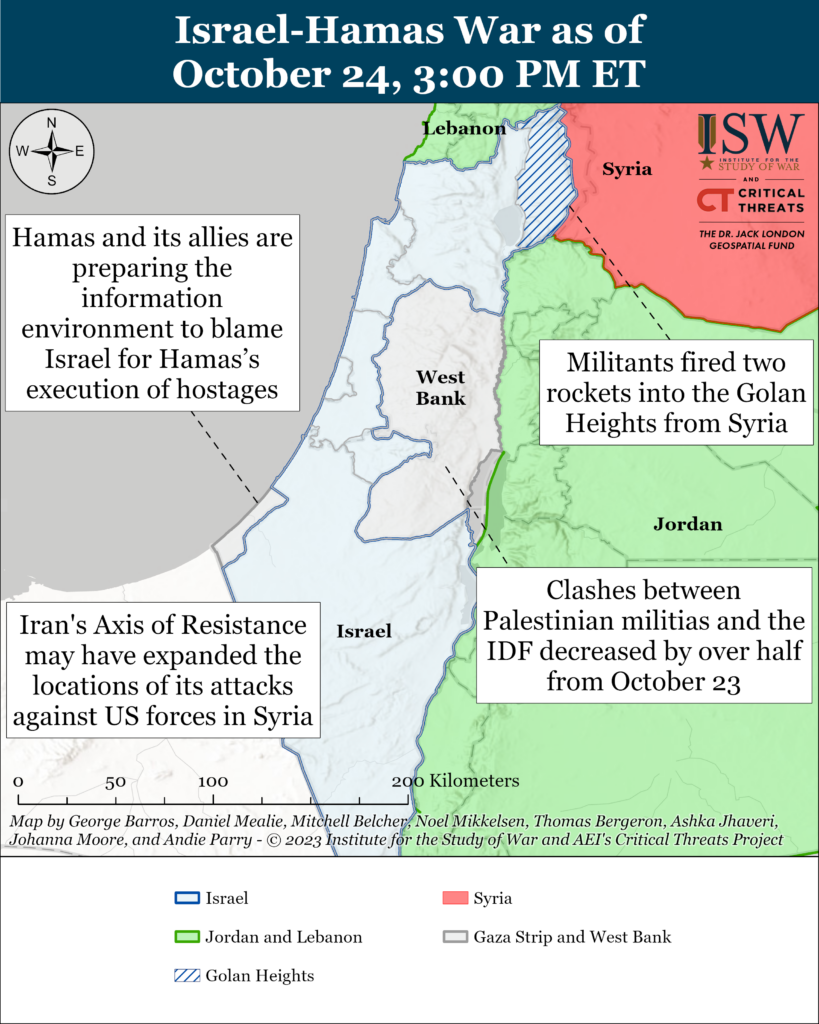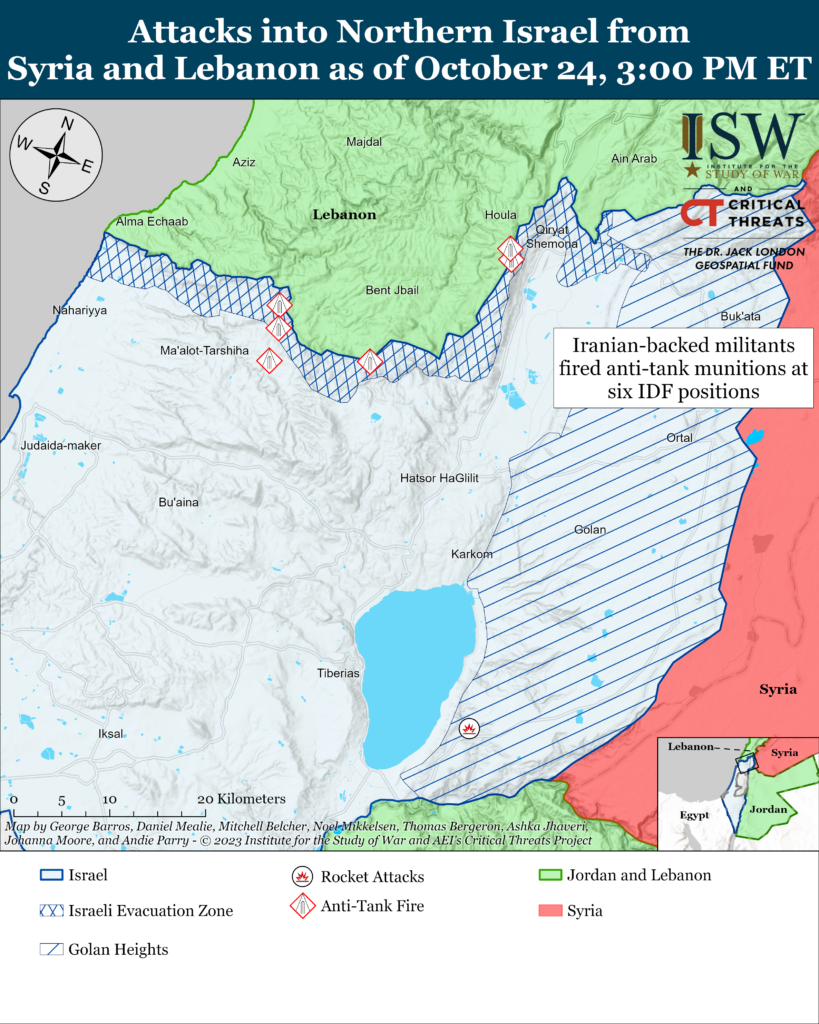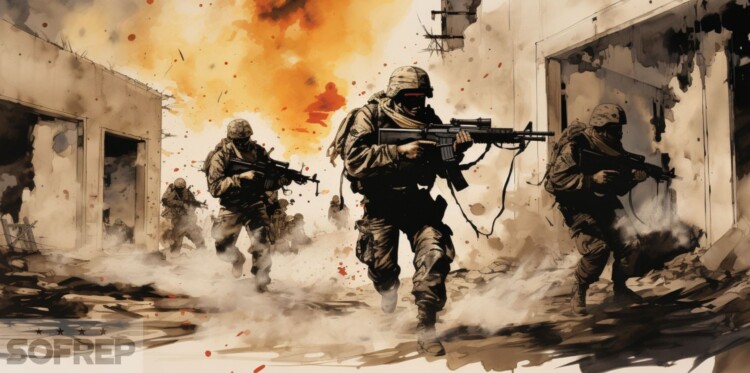The longstanding and deeply rooted struggle of the Israel-Hamas conflict witnessed its most recent major eruption of hostilities with Hamas’s October 7 terror attacks on Israel. This volatile confrontation, embedded in the broader Israeli-Palestinian dispute, is currently reshaping the socio-political landscape of the Middle East. Each new outburst of violence carries with it a toll of civilian casualties, deepening grievances, and a further entrenchment of opposing narratives. The recurrent flare-ups thwart efforts toward a lasting peace and challenge the stability of an already tumultuous region. This report delves into the recent developments in the Israel-Hamas war, shedding light on the unfolding dynamics and its broader implications for regional and global geopolitics.

Gaza
On October 24, the volatile atmosphere in the Gaza Strip saw no rest as Palestinian militant factions launched a series of attacks on Israeli territories. The militant wing of Hamas, known as the al Qassem Brigades, acknowledged orchestrating 11 indirect fire assaults. Similarly, Saraya al Quds, the armed wing of Palestinian Islamic Jihad (PIJ), carried out six attacks employing mortars and rockets. Furthermore, the al Aqsa Martyrs’ Brigade, associated with Fatah, and the Abu Ali Mustafa Brigades, recognized as a militant faction, have taken responsibility for two and three mortar attacks, respectively. In addition to these claimed attacks, two more rocket assaults were reported by Axis of Resistance-aligned media and Israeli Defense Forces (IDF) outlets. However, no group has claimed responsibility for these actions. The frequency of these attacks aligns with the recent observations made by the Critical Threats Project-Institute for the Study of War (CTP-ISW).
On the same day, a bold infiltration attempt from the Gaza Strip into Israel was recorded by CTP-ISW. A cadre of Hamas divers aiming to infiltrate Israel near the Zikim area was intercepted by IDF naval forces. The ensuing confrontation, as claimed by the al Qassem Brigades, took place near Zikim following the foiled infiltration attempt. Additional Palestinian sources illustrated a more intense scenario where fifteen Hamas fighters purportedly infiltrated the Zikim naval base, clashing with IDF forces. Palestinian media outlets reported six Hamas fighters were wounded in the skirmish with the IDF.

Hamas and its associates are working to shape the narrative to place the blame on Israel for any potential hostage casualties in Gaza, particularly if they proceed to execute hostages. On October 9, Hamas’ military spokesperson, Abu Ubaida, signaled a readiness to kill hostages to react to Israeli air attacks, aiming for strategic military or political advantages. Iranian media outlet Tasnim News Agency, a known affiliate of the Islamic Revolutionary Guard Corps, claimed on October 22 that Israel has a hidden agenda of getting Israeli captives killed, based on unnamed sources. On October 24, Palestinian Islamic Jihad representative Abu Hamza accused Israel of showing indifference towards the safety of hostages.
During the assault on October 7, Hamas and its allied factions captured hostages, likely as a tactic to deter a possible Israeli ground invasion in Gaza or to negotiate specific demands. However, the actions and statements from the Israeli side imply that Hamas and its allies might fail in achieving their objectives. Preparations for a potential ground incursion into Gaza by Israel are ongoing, and it was reported by the Wall Street Journal that talks between Israel and Hamas regarding the hostages broke down when Hamas requested the allowance of fuel shipments into Gaza. The Israel Defense Forces’ spokesperson denied fuel entry into the region, citing its utilization for Hamas’ military operations. Israeli intelligence suggests that Hamas and its allies are facing a fuel shortage, which could compel them to abandon their underground tunnel networks in Gaza once their fuel reserves run out.
Southern Lebanon and The Golan Heights
Militant groups supported by Iran, including the Lebanese Hezbollah (LH), have carried out six assaults as part of a persistent campaign aimed at IDF radar installations, sensor sites, and other military targets. LH has taken responsibility for two attacks employing anti-tank guided munitions (ATGM) against IDF posts near Israel’s northern border. They have also publicized a video showcasing earlier assaults on IDF radar and sensor facilities. Despite enduring losses in the ongoing border skirmishes as IDF forces engage ATGM teams gearing up to launch attacks into Israel, LH remains undeterred. A journalist with ties to LH conveyed the group’s objective to cripple IDF’s surveillance capabilities and restrict mechanical and personnel activities along the border through these assaults. The narrative aligns with Western and Israeli analyses, suggesting LH aims to preoccupy Israeli forces through these actions. This strategy fosters conditions for additional LH incursions into Israel and heightens the likelihood of a broader escalation, a notion previously highlighted by CTP-ISW.
On a related note, unidentified assailants in southwestern Syria fired two projectiles into the Golan Heights on October 24. This marked a deviation from the observed assault trend by CTP-ISW since the onset of the conflict, with five attacks recorded into the Golan Heights from Syria. Typically, such attacks from Syria occurred after Israeli airstrikes on Syrian airfields. Since October 7, the IDF has executed five aerial strikes on Damascus and Aleppo international airports to thwart potential Iranian endeavors to ferry military hardware and personnel to Syria. This fresh assault didn’t follow the previous pattern, where rocket fire into the Golan Heights would follow Israeli aerial assaults on Syrian airbases.

Amidst contrasting statements from LH and Lebanese authorities regarding the potential widening of the conflict to Lebanon, key Lebanese officials made a trip to the southern part of the country on October 24. During this visit, discussions on de-escalation and reinstating stability were held with the United Nations Interim Force leaders in Lebanon (UNIFIL). The commander of the Lebanese army emphasized the army’s vigilance and ongoing readiness at the southern frontier, mirroring the Lebanese prime minister’s sentiment of Lebanon as a nation inclined towards peace. Despite these affirmations, the control over LH forces in south Lebanon eludes the prime minister and the army commander, rendering them unable to enforce a de-escalation. In stark contrast, LH’s Deputy Secretary General, Naim Qassem, voiced a stern warning on the same day. He articulated LH’s pivotal role in defending the Gaza Strip, indicating a heightened state of readiness with their “hand on the trigger.”
The Axis of Resistance
In recent days, a coalition of Iranian-backed Iraqi militias, known as the Islamic Resistance of Iraq, has intensified its campaign against US bases in Iraq and Syria. Since October 18, they’ve launched 15 attacks, showcasing an expanding operational scope, especially in Syria. This aggression is considered Iran’s tactic to curb US support for Israel. On October 23, drones deployed by the group struck US forces at al Omar and al Shaddadi in Syria, marking a new front in their offensive. Following this, on October 24, they fired rockets at the Ain al Asad airbase in Iraq, bringing the total attacks on this site to five since October 18.
Tensions simmered when the leader of Harakat Hezbollah al Nujaba, a key faction within this coalition, lambasted the Iraqi government for not ousting US forces from Iraq on the same day. Moreover, attempts by Iraqi Prime Minister Mohammad Shia al Sudani to alleviate the situation met with refusal from prominent militias like Nujaba and Kataib Hezbollah, highlighting a challenging road to de-escalation.
In a worrying development, another militia, Alwiya Waad al Haq, threatened to target US forces in Kuwait and the UAE on October 24. This militia, believed to be a façade for Kataib Hezbollah, had attacked key sites in Saudi Arabia and the UAE earlier. The threats were echoed across pro-Iran channels, indicating a readiness among these militias to broaden their operational landscape beyond Iraq and Syria.
Iran, on its part, is shaping a narrative to pin any escalation on the US and Israel while portraying itself as a stabilizing force in the region. Supreme Leader Ali Khamenei accused Israel of scheming a direct war against Iran with US backing. On October 24, Iran’s stance of fostering regional stability amidst alleged US-led warmongering was reiterated by its Foreign Affairs Ministry spokesperson, Nasser Kanani. On the same day, Iran-backed factions emphasized their objective to deter US involvement in the Israel-Hamas conflict. A cadre of Iranian officials conveyed to al Araby al Jadeed that Iran’s support for militias is restrained, distancing Tehran from any major escalation. This rhetoric was furthered by Iran’s Ambassador to Russia, Kazem Jalali, who assigned any future escalation to US and Israeli actions.
This orchestrated narrative strategy aims to paint the US and Israel as the aggressors while portraying Iran as a responsible actor despite its direct involvement in fueling hostilities across Lebanon, Iraq, Syria, and Yemen through its proxy networks.










COMMENTS
You must become a subscriber or login to view or post comments on this article.